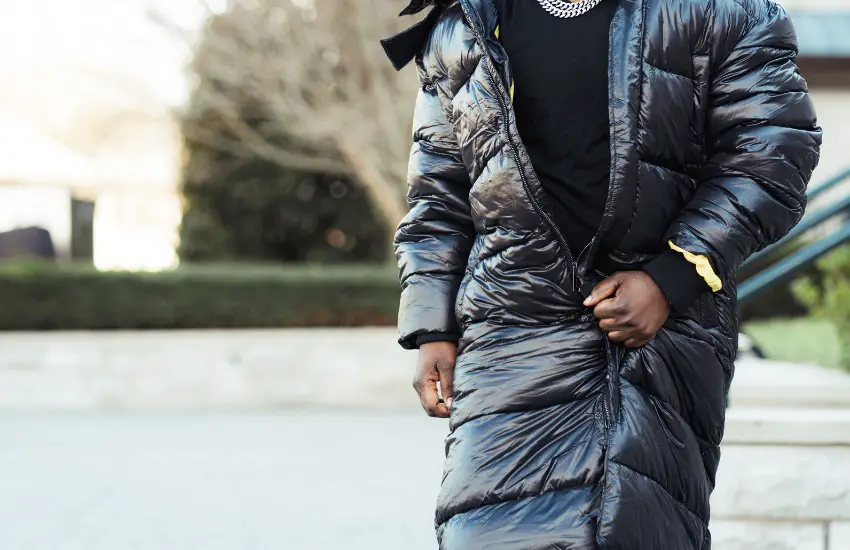Hiking In A Down Jacket (Worth A Shot?)

Gearing up for your next hiking adventure? One item that you might want to consider bringing with you is a trusty down jacket. These jackets have been around for ages and have stood the test of time for good reason. They’re perfect for keeping you warm and toasty when the temperatures start to drop.
In this article, we’ll explore whether it’s possible to hike in a down jacket, and if so, what to consider. We know that there are many questions swirling around in your head, like “Can I really wear a down jacket while hiking?” or “What should I look for in a down jacket for hiking?” Don’t worry, we’ve got you covered! So, grab a cup of hot cocoa, and let’s dive in!
Quick Links
Understanding The Insulation Of A Down Jacket
First things first – let’s talk science for a minute! Have you ever wondered how a simple jacket can keep you warm in freezing temperatures? Well, it’s all thanks to the magic of insulation, specifically down insulation in this case.
So, how does it work? Essentially, the feathers and down clusters inside the jacket trap warm air against your body, creating a barrier between you and the cold. The more down-fill power a jacket has, the better it is at trapping warm air, resulting in more warmth for you.
But that’s not all – down jackets are also incredibly lightweight and packable, making them a great choice for hiking. Plus, they provide excellent breathability, which means that you won’t get too hot and sweaty during strenuous activity.
So, what are the benefits of using a down jacket during hiking? For one, it can be a lifesaver in cold and wet conditions. It’s always better to be safe than sorry, and a down jacket can provide that extra layer of warmth when you need it most. Additionally, down jackets are versatile and can be worn both on and off the trail, making them a great investment for any outdoor enthusiast.
The Pros and Cons of Hiking in a Down Jacket
Ah, the classic pros and cons list! Let’s break down the advantages and disadvantages of hiking in a down jacket, shall we?
First, the pros! A down jacket is an excellent insulator and can provide a great deal of warmth, even in sub-zero temperatures. Plus, as we mentioned earlier, they’re lightweight and packable, which means that they won’t weigh you down or take up too much space in your pack. They’re also breathable, so you won’t get too hot and sweaty during strenuous activity. And finally, down jackets are incredibly versatile and can be worn both on and off the trail, making them a great investment for any outdoor enthusiast.
Now, onto the cons. While down jackets are great for cold and dry conditions, they don’t perform as well in wet weather. Once down gets wet, it loses its insulating properties, making it almost useless. So, if you’re hiking in an area where rain or snow is a possibility, you’ll need to take extra precautions to keep your jacket dry. Additionally, down jackets can be expensive compared to other types of jackets – such as a puffer jacket, so you’ll need to be prepared to make a bit of an investment if you want a high-quality one.
Overall, the pros of hiking in a down jacket outweigh the cons, but it’s important to be aware of both sides so that you can make an informed decision for your next hiking trip.
What To Consider When Choosing A Down Jacket For Hiking
Okay, now that you’re aware of the pros and cons of hiking in a down jacket, let’s talk about what to look for when choosing the perfect one for your hikes.
First, consider the warmth rating of the jacket. This is usually measured in fill power, which refers to the amount of down insulation in the jacket. The higher the fill power, the warmer the jacket will be. However, keep in mind that a higher fill power also means a higher price tag, so choose wisely based on your budget and the expected weather conditions.
Next up, weight and packability are key factors to consider when choosing a down jacket for hiking. You don’t want a jacket that’s too heavy and bulky, as it will weigh you down and take up valuable space in your pack. Look for a jacket that’s lightweight and compressible so that you can easily pack it away when you’re not using it. I know – it’s probably harder said that done.
Finally, water resistance is another important factor to consider. As we mentioned earlier, down jackets don’t perform well in wet conditions, so it’s essential to choose a jacket that has some degree of water resistance. Look for jackets with a durable water-repellent (DWR) coating, which will help keep you dry in light rain or snow.
How To Layer A Down Jacket For Hiking
Now that you’ve chosen your perfect down jacket for hiking, let’s talk about how to layer it properly for maximum warmth and comfort on the trail.
First things first, what should you wear under your down jacket? It’s always a good idea to start with a moisture-wicking base layer, such as a synthetic or wool shirt, to keep sweat away from your skin. This will help keep you dry and comfortable during strenuous activity.
Now, do you need to wear a base layer with your down jacket? It depends on the temperature and your personal preference. If it’s particularly cold outside, you may want to layer a base layer underneath your jacket for added warmth. However, if the weather is milder, you may be able to get away with just a t-shirt or thin long-sleeved shirt under your jacket.
Next, what should you wear over your down jacket? This will depend on the weather and your activity level. If it’s particularly cold and windy, you may want to layer a wind-resistant shell over your down jacket for added protection. However, if the weather is milder, you may be able to wear your down jacket as your outermost layer.
Finally, it’s important to be able to adjust your layers according to the weather. If the temperature starts to rise or you’re working up a sweat, you may need to remove layers to avoid overheating. On the other hand, if the weather takes a turn for the worse, you may need to add extra layers for added warmth and protection. Always be prepared for changing weather conditions by packing extra layers and adjusting your clothing as needed.
Safety Considerations When Hiking in a Down Jacket
As with any outdoor activity, safety should always be a top priority when hiking in a down jacket. While down jackets are great for keeping you warm and comfortable in cold weather, there are some risks associated with wearing them on the trail.
One of the main risks of hiking in a down jacket is that it can become wet and lose its insulating properties, leaving you cold and potentially hypothermic. To mitigate this risk, it’s important to check the weather forecast before your hike and avoid wearing your down jacket in rainy or wet conditions. If you do encounter wet conditions on the trail, be sure to have a backup plan, such as a waterproof shell or extra layers, to keep you warm and dry.
Another risk of hiking in a down jacket is that it can be more flammable than other materials, such as synthetic insulation. To reduce the risk of fire, be sure to avoid wearing your down jacket near open flames, such as campfires, and follow all fire safety guidelines.
Finally, it’s important to be aware of the weight and bulk of your down jacket when hiking. A heavy or bulky jacket can weigh you down and limit your mobility on the trail, increasing your risk of injury. To avoid this, choose a lightweight and compressible down jacket that won’t weigh you down or take up too much space in your pack.
Conclusion
In conclusion, hiking in a down jacket can be a great way to stay warm and comfortable on the trail, as long as you take the necessary precautions and choose the right jacket for your needs.
From understanding the insulation properties of down jackets to layering properly and being aware of safety considerations, there’s a lot to consider when hiking in a down jacket. But with the right knowledge and preparation, you can enjoy all the benefits that a down jacket offers while on your hikes. So next time you hit the trail, don’t forget to pack your down jacket and get ready for a warm and comfortable adventure!






